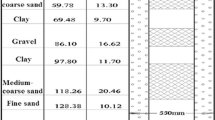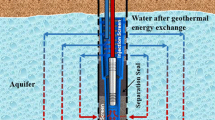Abstract
Thermal feedback and thermal recycling in open-loop groundwater heat pump (GWHP) systems occurs when a fraction of the injected water in a well doublet returns to the production well. They reflect two different mathematical representations of the same physical process. Thermal feedback assumes a constant injection temperature, while thermal recycling couples the injection and production temperatures by a constant temperature difference. It is shown that thermal feedback, commonly used in GWHP design, and recycling reflect two thermal end-members. This work addresses the coupled problem of thermal recycling, which is, so far, the missing link for complete GWHP assessment. An analytical solution is presented to determine the return-flow fraction in a well doublet and is combined with a heat-balance calculation to determine the steady-state well temperatures in response to thermal feedback and recycling. This is then extended to advective-dispersive systems using transfer functions, revealing that the well temperatures in response to thermal feedback and recycling are functions of the capture probability. Conjunctive interpretation of thermal feedback and recycling yields a novel design approach with which major difficulties in the assessment of the sustainability of GWHP systems can be addressed.
Résumé
Le percement thermique et le recyclage thermique se produisent dans un doublet géothermique ouvert lorsqu’une fraction de l’eau injectée retourne au puits productif. Ils reflètent deux représentations mathématiques du même processus. Le percement thermique suppose une température d’injection constante, alors que le recyclage thermique relie la température d’injection et de production par une différence de température constante. On montre que le percement thermique, communément utilisé pour le dimensionnement de doublets géothermiques, et le recyclage définissent deux cas de sollicitation thermique extrêmes. Cet article traite du problème couplé du recyclage thermique, en général négligé lors de l’évaluation d’un doublet géothermique ouvert. Une solution analytique est établie pour déterminer la fraction du débit de retour, puis combinée avec un bilan thermique donnant les températures d'équilibre aux puits en réponse au percement thermique et au recyclage thermique. Cette nouvelle approche est ensuite étendue aux systèmes advectif-dispersifs au moyen des fonctions de transfert, révélant que ces températures d'équilibre sont entièrement déterminées par la probabilité de capture du puits productif. L'interprétation combinée des effets liés au percement thermique et au recyclage thermique fournit des critères plus réalistes pour le dimensionnement et l'évaluation des performances d'un doublet géothermique ouvert.
Resumen
La retroalimentación térmica y el reciclado térmico en sistemas de bomba de calor de agua subterránea en circuito abierto (GWHP) ocurren cuando una fracción del agua inyectada en pozos dobles retorna al pozo de producción. Ello configura dos representaciones matemáticas diferentes de un mismo proceso físico. La retroalimentación térmica supone una inyección a temperatura constante, mientras que el reciclado térmico la inyección se acopla a la temperatura de producción a través de una diferencia de temperatura constante. Se muestra que la retroalimentación térmica, comúnmente usada en el diseño GWHP, y el reciclado reflejan dos miembros térmicos extremos. Este trabajo aborda el problema del acoplamiento del reciclado térmico, que es, hasta aquí, el eslabón perdido para completar la evaluación de GWHP. Se presenta una solución analítica para determinar la fracción del flujo de retorno en un pozo doble y se combina con un cálculo de balance de calor para determinar el estado estacionario de temperaturas del pozo en respuesta a la retroalimentación y al reciclado térmico. Esto es luego extendido a sistemas dispersivos – advectivos usando funciones de transferencia, lo que revela que las temperaturas del pozo en respuesta a la retroalimentación y reciclado térmico son funciones de la probabilidad de captura. La interpretación conjunta de retroalimentación y reciclado térmico brinda un enfoque de nuevo diseño con el cual pueden ser abordadas las mayores dificultades en la evaluación de la sustentabilidad de los sistemas GWHP.
Resumo
Retorno térmico e reciclagem térmica em sistemas de bombas de calor baseados em água subterrânea em circuito aberto (open-loop groundwater heat pump – GWHP) ocorrem quando uma fração da água injetada no furo emparelhado retorna ao furo de produção. Estes termos correspondem a duas representações matemáticas do mesmo processo físico. O retorno térmico assume uma temperatura constante de injeção, enquanto a reciclagem térmica agrega as temperaturas de injeção e de produção através de uma diferença de temperatura constante. É mostrado que o retorno térmico, comummente usado nos projetos GWHP, e a reciclagem refletem dois membros térmicos finais. Este trabalho analisa o problema acoplado da reciclagem termal, o qual é, até agora, o elo perdido para avaliação completa do GWHP. É apresentada uma solução analítica para determinar a fração de retorno de fluxo num furo emparelhado e é combinada com um cálculo de balanço de calor para determinar o estado estável da temperatura nos furos em resposta ao retorno e reciclagem térmicas. Isto é então estendido a sistemas advetivo-dispersivos, recorrendo ao uso de funções de transferência, mostrando que as temperaturas no furo em resposta ao retorno e reciclagem térmicas são funções da probabilidade de captura. A interpretação conjuntiva do retorno e reciclagem térmicas leva a uma nova forma de aproximação que pode resolver situações que apresentavam maiores dificuldades de avaliação da sustentabilidade dos GWHP.



Similar content being viewed by others
References
Banks D (2007) Thermogeological assessment of open loop well doublet schemes: an analytical approach. Proc. 27th Annual Conference of the Irish Group of the International Association of Hydrogeologists, Tullamore, Ireland, 24–25 April 2007
Banks D (2008) An introduction to thermogeology: ground source heating and cooling. Blackwell, Oxford, 339 pp
Banks D (2009) Thermogeological assessment of open-loop well-doublet schemes: a review and synthesis of analytical approaches. Hydrogeol J 17:1149–1155
Clyde CG, Madabhushi GV (1983) Spacing of wells for heat pumps. J Water Resour Plan Manage 109(3):203–212
Cornaton F, Perrochet P (2006a) Groundwater age, life expectancy and transit time distributions in advective-dispersive systems: 1. generalized reservoir theory. Adv Water Res 29(9):1267–1291
Cornaton F, Perrochet P (2006b) Groundwater age, life expectancy and transit time distributions in advective-dispersive systems: 2. reservoir theory for sub-drainage basins. Adv Water Res 29(9):1292–1305
Ferguson G (2006) Potential use of particle tracking in the analysis of low-temperature geothermal developments. Geothermics 35:44–58
Frind EO, Muhammad DS, Molson JW (2002) Delineation of three-dimensional well capture zones for complex multi-aquifer systems. Ground Water 40(6):586–598
Gringarten AC, Sauty JP (1975) A theoretical study of heat extraction from aquifers with uniform regional flow. J Geophys Res 80:4956–4962
Javandel I, Tsang CF (1986) Capture-zone type curves: a tool for aquifer cleanup. Ground Water 24(5):616–625
Jury WA, Roth K (1990) Transfer functions and solute movement through soil: theory and applications, Birkhäuser, 226 pp
Lippmann MJ, Tsang CF (1980) Groundwater use for cooling: associated aquifer temperature changes. Ground Water 18(5):452–458
Lo Russo S, Civita MV (2009) Open-loop groundwater heat pumps development for large buildings: a case study. Geothermics 38:335–345
Luo J, Kitanidis PK (2004) Fluid residence times within a recirculation zone created by an extraction-injection well pair. J Hydrol 295:149–162
Milnes E, Perrochet P (2006) Direct simulation of solute recycling in irrigated areas. Adv Water Res 29(8):1140–1154
Milnes E, Perrochet P (2007) Simultaneous identification of a single pollution point-source location and contamination time under known flow field conditions. Adv Water Res 30(12):2439–2446
Neupauer RM, Wilson JL (2002) Backward probabilistic model of groundwater contamination in non-uniform and transient flow. Water Resour Res 25(7):733–746
OFEV (2009) Exploitation de la chaleur tirée du du sous-sol. Aide à l’exécution destinée aux autorités et aux spécialistes de géothermie [Exploitation of heat extracted from the ground. Guidelines for administrations and specialists in the field of geothermics]. Published by Office Fédéral de l’Environnement, Bern, Switzerland. Available via http://www.bafu.admin.ch/publikationen/publikation/01042/index.html?lang=fr. Accessed 20 July 2012
Rafferty KD (1996) Well-pumping issues in commercial groundwater heat pump systems. ASHRAE Trans 104(1B):927–931
Strack O (1989) Groundwater Mechanics, Prentice-Hall, Upper Saddle River, NJ, 732 pp
Warner DL, Algan U (1984) Thermal impact of residential ground-water heat pumps. Ground Water 22(1):6–12
Zhao Y, Zhang SG, Xun L (2003) Cost-effective optimal design of groundwater source heat pumps. Appl Geotherm Eng 23(13):1595–1603
Acknowledgements
The conspicuous review comments by Dr Jerry Fairley were highly appreciated as well as constructive criticism by two anonymous reviewers.
Author information
Authors and Affiliations
Corresponding author
Appendix: Characteristic parameters of a well doublet with partial recirculation in an aquifer with uniform regional flow
Appendix: Characteristic parameters of a well doublet with partial recirculation in an aquifer with uniform regional flow
The complex potential, Ω, resulting from the implementation of a well doublet parallel to a 2D uniform flow field in the (x, y)–plane, with the injecting well located downstream, is classically obtained (e.g. Strack 1989; Javandel and Tsang 1986; Luo and Kitanidis 2004) by the superposition
where b is the aquifer thickness and z is the coordinate in the complex plane. The first two terms correspond, respectively, to the flow rate Q extracted at z = −d and to the same flow rate injected (−Q) at z = d, while the third term accounts for the regional uniform Darcy flux q defined positive in the direction of the real axis (Fig. 4). The two wells are therefore centred about the origin along the x-axis and are separated by the distance L = 2d.
The complex function above features the hydraulic potential h and the stream function ψ as real and imaginary parts, respectively, so that
where k is the hydraulic conductivity of the medium.
Using the dimensionless variables
the complex potential becomes
and is illustrated in Fig. 4, where the dimensionless hydraulic potential h′ and stream function ψ′ are represented for the dimensionless flow rate X = 3.
According to the complex potential theory, the dimensionless specific discharge is obtained by the differentiation
This function has no complex components at either purely real or purely imaginary locations. It is singular at the well points and vanishes at the stagnation points \( {z\prime_{\text{s}}} \).
Setting W′ (\( {z\prime_{\text{s}}} \)) = 0 in (Eq. 23) yields
Hence, as long as X < 1, two stagnation points are located on the real axis (y′ = 0) and there is no recirculation from the injection well to the pumping well. As X increases, the stagnation points shift towards the origin, merge at \( {z\prime_{\text{s}}} = 0 \) when X = 1, and then shift away along the imaginary axis (x′ = 0), as indicated by (Eq. 25) for X > 1. In true dimensions, the stagnation points are located at x = 0 and \( y = \pm \,d\,\sqrt {{X-1}} \).
In this latter case, a recirculation cell develops and a fraction of the injected flow rate returns to the pumping well.
The shortest travel time of the recycled water particles is the hydraulic breakthrough-time, dictated by the inverse of the specific discharge along the straight flow-path connecting the two wells. Given that specific discharge has no complex components along this path, this characteristic time is easily obtained, in dimensionless form, by
with the limit value \( {t\prime_{{{ \min }}}} = 4\pi / 3 \) when X –– > ∞.
In true dimensions, \( {t_{{{ \min }}}} = {t\prime_{{{ \min }}}}\phi \,b\,{d^2} / Q \) where \( \phi \) is the porosity of the medium.
The fraction of the flow rate recycled in the well doublet is expected to increase with the flow rate itself. Under increasing recycling conditions, the stagnation points (Eq. 25) are always at purely imaginary locations and connected by a straight (equipotential) line intersecting all recirculating flow-paths. As specific discharge always remains real-valued along this line (Eq. 23), the fraction recycled is therefore straightforwardly obtained by
Rights and permissions
About this article
Cite this article
Milnes, E., Perrochet, P. Assessing the impact of thermal feedback and recycling in open-loop groundwater heat pump (GWHP) systems: a complementary design tool. Hydrogeol J 21, 505–514 (2013). https://doi.org/10.1007/s10040-012-0902-y
Received:
Accepted:
Published:
Issue Date:
DOI: https://doi.org/10.1007/s10040-012-0902-y





